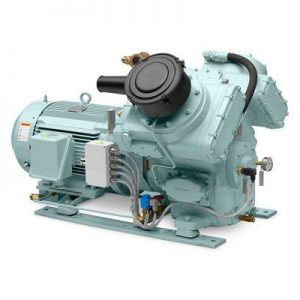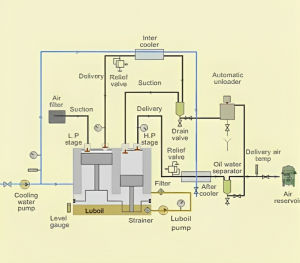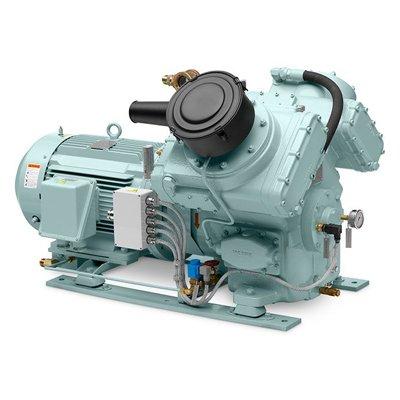Air compressors play a vital role in the operation of commercial vessels. Installed in the engine room, they provide compressed air for various onboard systems and equipment. This article will discuss the types, functions, components, and maintenance of air compressors used in ship engine rooms.
1. Types of Air Compressors
There are three primary types of air compressors commonly found in ship engine rooms:
1.1. Reciprocating Air Compressors
Reciprocating air compressors use a piston within a cylinder to compress air. They are typically preferred for their simplicity, robustness, and ability to produce high-pressure air. These compressors are often found in the starting air system for the main and auxiliary engines.

1.2. Rotary Screw Air Compressors
Rotary screw compressors utilize two intermeshing helical rotors to compress air. They are known for their efficiency, continuous operation, and low noise levels. They are often used for general service air and control air systems.
1.3. Centrifugal Air Compressors
Centrifugal compressors use rotating impellers to impart kinetic energy to the air and then convert it into pressure energy. They are suited for high flow rates and are used in larger vessels or specialized applications.
2. Functions of Air Compressors in Ship Engine Rooms
Air compressors serve several essential functions in ship engine rooms:
2.1. Starting Air System Compressed air is used to start the main and auxiliary engines. High-pressure air is injected into the engine cylinders to initiate the combustion process, providing the initial torque required to start the engine.
2.2. Control Air System Control air is used to operate pneumatic instruments, valves, and controllers throughout the vessel. This system ensures smooth operation and precise control of various shipboard systems.
2.3. General Service Air System General service air is used for cleaning, maintenance, and other onboard tasks. It can be used to operate pneumatic tools, blow out pipelines, and clean machinery components.
2.4. Emergency Air Supply Compressed air can be used as an emergency power source for critical safety systems, such as firefighting equipment or emergency shutdown systems.
3. Air Compressor Components and Accessories
Key components of air compressors include:
3.1. Air Intake Filters These filters remove dust, dirt, and other contaminants from the intake air, ensuring that the compressed air is clean and the compressor components are protected from damage.
3.2. Intercoolers and Aftercoolers Intercoolers and aftercoolers help reduce the temperature of compressed air, minimizing the risk of damage to downstream components and improving efficiency.
3.3. Air Receiver Tanks Air receiver tanks store compressed air, providing a buffer to meet fluctuations in demand and ensure stable pressure.
3.4. Pressure Switches and Safety Valves Pressure switches control the compressor’s operation by turning it on and off based on the air pressure in the receiver tank. Safety valves protect the system by venting excess pressure if the pressure exceeds a set limit.
3.5. Lubrication Systems and Oil Separators Lubrication systems reduce friction and wear between moving components. Oil separators remove oil from the compressed air, preventing contamination of downstream systems.
4.Maintenance and Troubleshooting of Air Compressors
Regular maintenance is essential to ensure the reliability and efficiency of air compressors:
Periodic Inspections and Preventive Maintenance Regular inspections and servicing, such as checking lubrication levels, changing filters, and examining belts, help prevent compressor failures and extend the equipment’s life.
Common Air Compressor Problems and Solutions Some common issues include overheating, excessive noise, and pressure fluctuations.
5. Use of Air Compressors on Ships
Air compressors are essential components on ships, serving a variety of purposes across numerous applications. Different types of air compressors are utilized onboard for specific tasks and requirements.
- Starting air for machinery and main engines: Air compressors supply the starting air needed to initiate the operation of various machines and the ship’s main engine.
- Compressed air for control systems: Pressurized air from compressors is used in control valves, throttle controls, and other monitoring systems that rely on pneumatic mechanisms.
- Auxiliary engine operations: Compressed air controls several processes within auxiliary engines as well.
- Pneumatic tools and cleaning devices: Compressed air powers pneumatic tools and cleaning equipment, ensuring efficient operation and maintenance.
- Whistling and foghorn operations: Ships use compressed air to operate whistles and foghorns as signaling devices.
- Hydraulic jack lifting: Hydraulic jacks on ships utilize compressed air to perform lifting operations.
- Starting boilers, refrigerants, and heat exchangers: Compressed air is often used to start boilers, refrigeration systems, and heat exchangers on ships.
- Propeller maneuvering systems: In some cases, compressed air is employed to kick-start the propellers of the ship’s maneuvering system.
In summary, air compressors are mechanical devices that operate on thermodynamic principles, compressing air to increase its pressure. This highly pressurized air is then used to power various systems, including main and auxiliary engines, heat exchangers, and boilers, among others.
Operational procedure of main air compressor
Double-acting reciprocating air compressors are the most common type used in the marine industry, with multiple compressors installed on ships to serve different purposes. The wide-ranging applications of air compressors on ships, from simple cleaning tasks to crucial engine operations and even propelling the vessel, make them indispensable components onboard.

The air is drawn into the compressor through an air filter and then compressed. The compressed air is cooled using an inter-cooler and an after-cooler. Oil-water separators are included to separate oil and moisture from the compressed air. Low-pressure and high-pressure stage drains are connected to an automatic unloader, which unloads the compressor during starting and stopping. The compressed air is then delivered to an air reservoir for storage.
Before starting the compressor, perform the following checks:
- Lube oil level: Ensure the oil level in the sump is normal via the level gauge. High oil levels can cause oil carryover, while low levels can result in inadequate lubrication.
- Delivery side valves: Verify that the air bottle filling valve and compressor delivery valve are open. Starting the air compressor with the delivery side valves closed can cause the relief valve to lift, potentially leading to a compressor explosion if the relief valve malfunctions.
- Drain valves: Confirm that the low-pressure and high-pressure stage drain valves are open. Starting the compressor with the drain valves closed can overload the compressor.
- Cooling water system valves: Ensure all seawater and freshwater system valves are open. Restricted cooling water flow can increase cooling water and air temperatures.
- Load on generators: Check that the generators can handle the compressor’s load. The compressor motor consumes 30 kilowatts while running, with a higher starting current.
During the compressor starting, perform these checks:
- Air compressor starting: Start the compressor and confirm that the automatic unloader has closed the drain by listening for the sound of air draining to stop. Additionally, verify that the compressor is loaded.
- Compressor motor current: Monitor the compressor motor’s current in the ammeter. Higher-than-normal current indicates an overloaded compressor.
During operation, perform these checks:
- Lube oil pressure: Ensure the lube oil pressure is normal, around 2.8 bar. Low lube oil pressure can lead to improper lubrication.
- Cooling water temperature and pressure: Monitor the cooling water temperature and pressure. Maintain the cooling water inlet temperature between 30 and 40 degrees Celsius, with a pressure of around 3.0 bar. Cooling water pressure and temperature can impact air temperature.
- Delivery air temperature: Observe the delivery air temperature, as it can affect cylinder lubrication and compressor efficiency.
- LP and HP delivery air pressure: Check the first and second stage delivery air pressure and note the time taken to fill the air reservoir.
- Air reservoir pressure: Monitor the air reservoir pressure, as it can indicate compressor performance.
- Abnormal noise or vibration: Listen for abnormal noise or vibrations. Stop the compressor immediately if any abnormalities are detected and do not restart it without investigating the cause.
During compressor stopping, perform these checks:
- Unloader and drain opening: Upon stopping the compressor, verify that the unloader opens to drain the air. For compressors without an unloader, open the drains before stopping and then stop the compressor.
By the MaritimEducation Team.

